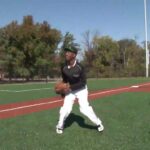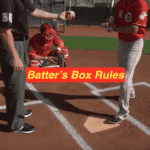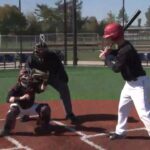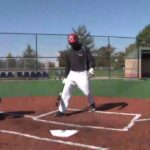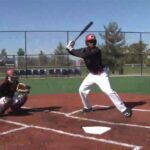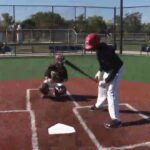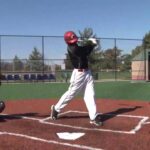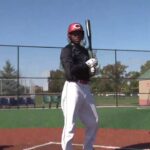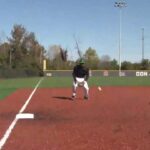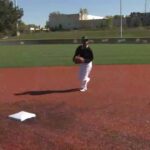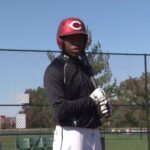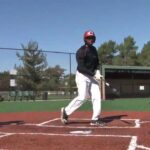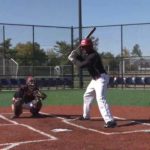2.00 Definition of Terms
(All definitions in Rule 2.00 are listed alphabetically)
ADJUDGED is a judgment decision by an umpire.
An APPEAL is an act of a fielder in claiming a violation of the rules by the offensive team.
An AT-BAT, for the purposes of meeting the requirements of Mandatory Play (if applicable), is when a batter assumes the position of a batter with no count and is retired or reaches base. An at-bat for scorekeeping/ statistical purposes is defined in the publication, “What’s the Score?”
A BACKSTOP is the barrier erected behind the catcher in order to allow the catcher to retrieve passed balls easily.
A BALK is an illegal act by the pitcher with a runner or runners on base entitling all runners to advance one base (Intermediate (50-70) Division/ Junior/ Senior/ Big League). A balk is not called in the Little League (Major) Division and below. (See Rule 8.05 – Illegal Pitch.)
A BALL is a pitch which does not enter the strike zone in flight and is not struck at by the batter. (NOTE: If the pitch touches the ground and bounces through the strike zone it is a “ball.” If such a pitch touches the batter, the batter shall be awarded first base. If the batter swings at such a pitch and misses, it is a strike. (Majors/ Intermediate (50-70) Division/ Junior/ Senior/ Big League: If the batter swings at such a pitch after two strikes, the ball cannot be caught for the purposes of Rule 6.05(b) and 6.09(b). If the batter hits such a pitch, the ensuing action shall be the same as if the batter hit the ball in flight.)
A BASE is one of four points which must be touched by a runner in order to score a run; more usually applied to the canvas bags and the rubber plate which mark the base points.
A BASE COACH is a team member in uniform or an adult manager and/ or coach who is stationed in the base coach’s box at first and/ or third base to direct the batter and the runners. NOTE: Two (2) adult base coaches are permitted at all levels. The second coach may be 16 years or older. See Rule 4.05( 2) for restrictions.
A BASE ON BALLS is an award of first base granted to batters who, during their time at bat, receive four pitches outside the strike zone.
A BATTER is an offensive player who takes a position in the batter’s box.
BATTER-RUNNER is a term that identifies the offensive player who has just finished a time at bat until that player is retired or until the play on which that player becomes a runner ends.
The BATTER’S BOX is the area within which the batter must stand during a time at bat.
The BATTERY is the pitcher and catcher.
The BATTING ORDER is the list of current defensive players (and the designated hitter in Senior/ Big League) in the order in which they are to bat. Exceptions: In all divisions, the batting order may contain the entire roster of players. In Tee Ball and Minor League, the batting order shall contain the entire roster of players.
BENCH or DUGOUT is the seating facilities reserved for players, substitutes, one manager, and not more than two coaches when they are not actively engaged on the playing field. Batboys and/ or batgirls are not permitted.
A.R.— Bench or dugout is not for additional coaches or scorekeepers.
A BUNT is a batted ball not swung at, but intentionally met with the bat and tapped slowly. The mere holding of the bat in the strike zone is not an attempted bunt. (Tee Ball: Bunts are not permitted. Batters are not permitted to take a half-swing. If the umpire feels the batter is taking a half-swing, the batter may be called back to swing again.)
A.R.— If no attempt is made to make contact with a ball outside the strike zone while in the bunting stance, it shall be called a ball. The batter must offer at the pitch for it to be a strike.
A CALLED GAME is one in which, for any reason, the Umpire-in-Chief terminates play.
A CATCH is the act of a fielder in getting secure possession in the hand or glove of a ball in flight and firmly holding it before it touches the ground providing such fielder does not use cap, protector, pocket, or any other part of the uniform in getting possession. It is not a catch, however, if simultaneously or immediately following contact with the ball, the fielder collides with a player, or with a wall, or if that fielder falls down, and as a result of such collision or falling, drops the ball. It is not a catch if a fielder touches a fly ball which then hits a member of the offensive team or an umpire and then is caught by another defensive player. If the fielder has made the catch and drops the ball while in the act of making a throw following the catch, the ball shall be adjudged to have been caught. In establishing the validity of the catch, the fielder shall hold the ball long enough to prove complete control of the ball and that release of the ball is voluntary and intentional. A catch is legal if the ball is finally held by any fielder, even though juggled, or held by another fielder before it touches the ground. Runners may leave their bases the instant the first fielder touches the ball.
The CATCHER is the fielder who takes the position back of the home base.
The CATCHER’S BOX is that area within which the catcher shall stand until the pitcher delivers the ball. (See Rule 4.03)
A COACH is an adult appointed to perform such duties as the manager may designate. NOTE: If two (2) coaches are appointed, the second coach may be age 16 or older.
A DEAD BALL is a ball out of play because of a legally created temporary suspension of play.
The DEFENSE (or DEFENSIVE) is the team, or any player of the team, in the field.
A DOUBLE HEADER is two regularly scheduled or rescheduled games, played by the same team( s) on the same day.
A DOUBLE PLAY is a play by the defense in which two offensive players are retired as a result of continuous action, providing there is no error between putouts. (a) A force double play is one in which both putouts are force plays. (b) A reverse force double play is one in which the first out is made at any base and the second out is made by tagging a runner who originally was forced, before the runner touches the base to which that runner was forced.
DUGOUT (see definition of “BENCH”)
A FAIR BALL is a batted ball that settles on fair ground between home and first base, or between home and third base, or that is on or over fair territory when bounding to the outfield past first or third base, or that touches first, second, or third base, or that first falls on fair territory on or beyond first base or third base, or that, while on or over fair territory touches the person of an umpire or player, or that, while over fair territory, passes out of the playing field in flight.
NOTE: A fair fly shall be adjudged according to the relative position of the ball and the foul line, including the foul pole, and not as to whether the fielder is on fair or foul territory at the time such fielder touches the ball.
FAIR TERRITORY is that part of the playing field within, and including the first base and third base lines, from home base to the bottom of the playing field fence and perpendicularly upwards. Home plate, first base and third base and all foul lines are in fair territory.
A FIELDER is any defensive player.
FIELDER’S CHOICE is the act of a fielder who handles a fair grounder and, instead of throwing it to first base to put out the batter-runner, throws to another base in an attempt to put out a preceding runner. The term is also used by scorers (a) to account for the advance of the batter-runner who takes one or more extra bases when the fielder who handles the safe hit attempts to put out a preceding runner; (b) to account for the advance of a runner (other than by stolen base or error) while a fielder is attempting to put out another runner; and (c) to account for the advance of a runner made solely because of the defensive team’s indifference. (undefended steal).
A FLY BALL is a batted ball that goes high in the air in flight.
A FORCE PLAY is a play in which a runner legally loses the right to occupy a base by reason of the batter becoming a runner. (NOTE: Confusion regarding this play is removed by remembering that frequently the “force” situation is removed during the play. Example: Runner on first, one out, ground ball hit sharply to first baseman, who touches the base and the batter-runner is out. The force is removed at that moment and the runner advancing to second must be tagged. If there had been a runner at second or third, and either of these runners scored before the tag-out at second, the run( s) would count. Had the first baseman thrown to second and the ball had been returned to first, the play at second would have been a force-out, making two outs, and the return throw to first would have made the third out. In that case, no run would score.)
A.R.— Runners forced to advance as a result of the batter-runner being awarded first base.
A FORFEITED GAME is a game declared ended by the Umpire-in-Chief in favor of the offended team by the score of 6 to 0 , for violation of the rules. (Tee Ball: There shall be no forfeits in Tee Ball.)
A FOUL BALL is a batted ball that settles on foul territory between home and first base, or between home and third base, or that bounds past first or third base on or over foul territory, or that first falls on foul territory beyond first or third base, or that while on or over foul territory, touches the person of an umpire or player, or any object foreign to the natural ground.
NOTE 1: A foul fly shall be judged according to the relative position of the ball and the foul line, including the foul pole, and not as to whether the fielder is on foul or fair territory at the time that fielder touches the ball.
NOTE 2: In Tee Ball, the ball is foul if it travels less than 15 feet in fair territory from home plate. The ball is also foul if the batter hits the tee with the bat.
FOUL TERRITORY is that part of the playing field outside the first and third base lines extended to the fence and perpendicularly upwards.
A FOUL TIP is a batted ball that goes sharp and direct from the bat to the catcher’s hands and is legally caught. It is not a foul tip unless caught and any foul tip that is caught is a strike, and the ball is in play. It is not a catch if it is a rebound, unless the ball has first touched the catcher’s glove or hand. A foul tip can only be caught by the catcher.
A GROUND BALL is a batted ball that rolls or bounces close to the ground.
The HOME TEAM is the team which takes the field first at the start of the game. Adopted schedules will determine which team this will be.
ILLEGAL (or ILLEGALLY) is contrary to these rules.
An ILLEGAL BAT is a bat that has been altered or a bat that is not approved for play because it does not meet specifications with regard to length, weight, barrel diameter, labeling, or performance standard for the division in which it is used. Penalty – See Rule 6.06( d).
An ILLEGAL PITCH is (1) a pitch delivered to the batter when the pitcher does not have the pivot foot in contact with the pitcher’s plate; or (2) a quick return pitch. Intermediate (50-70) Division/ Junior/ Senior/ Big League: An illegal pitch with runners on base is a balk. (See also definition of “Pitch.”)
A.R.— This would apply to rule 8.05(e) and 8.05(g). In all other instances of Rule 8.05 with no runners on base, no penalty is enforced. In such cases, the umpire shall call “Time” and the pitcher and batter will resume the count without reference to the pitch.
An ILLEGALLY BATTED BALL is one hit by the batter with one or both feet on the ground entirely outside the batter’s box.
INELIGIBLE PITCHER – Applies to regular season violations of Regulation VI. (See also Rule 4.19.)
INELIGIBLE PLAYER – Applies to regular season violations of regulations regarding league age, residence or school attendance (as defined by Little League International), and participation on the proper team within the local league. (See also Rule 4.19.)
The INFIELD is that portion of the field in fair territory, which includes areas normally covered by infielders.
An INFIELDER is a fielder who occupies a position in the infield.
An INFIELD FLY is a fair fly ball (not including a line drive nor an attempted bunt) which can be caught by an infielder with ordinary effort, when first and second, or first, second and third bases are occupied, before two are out. The pitcher, catcher, and any outfielder stationed in the infield on the play shall be considered infielders for the purpose of this rule.
When it seems apparent that a batted ball will be an Infield Fly, the umpire shall immediately declare “Infield Fly” for the benefit of the runners. If the ball is near the baseline, the umpire shall declare “Infield Fly, if fair.”
The ball is alive and runners may advance at the risk of that ball being caught, or retouch and advance after the ball is touched, the same as on any fly ball. If the hit becomes a foul ball, it is treated the same as any foul.
NOTE 1: If a declared Infield Fly is allowed to fall untouched to the ground, and bounces foul and remains foul before passing first or third base, it is a foul ball. If a declared Infield Fly falls untouched to the ground outside the baseline, and bounces fair before passing first or third base, it is an Infield Fly.
NOTE 2: The Infield Fly Rule does not apply in Tee Ball.
A.R.— The infield dirt and the outfield grass do not form a boundary line for infield fly purposes.
IN FLIGHT describes a batted, thrown, or pitched ball which has not yet touched the ground or some object other than a fielder. If the pitch touches the ground and bounces through the strike zone, without being struck at by the batter, it is a “ball.” If such a pitch touches the batter, that batter shall be awarded first base.
Majors/ Intermediate (50-70) Division/ Junior/ Senior/ Big League: If the batter swings at such a pitch after two strikes, the ball cannot be caught for the purpose of Rule 6.05( b). If the batter hits such a pitch, the ensuing action shall be the same as if the ball was hit in flight.
IN JEOPARDY is a term indicating that the ball is in play and an offensive player may be put out.
An INNING is that portion of a game within which the teams alternate on offense and defense and in which there are three putouts for each team. Each team’s time at bat is a half-inning. It will be held that an inning starts the moment the third out is made completing the preceding inning. (Minor League Only – A five-run limit is to be imposed which would complete the half inning.)
INTERFERENCE
(a) Offensive interference is an act by a member of the team at bat which interferes with, obstructs, impedes, hinders, or confuses any fielder attempting to make a play. If the umpire declares the batter, batter-runner, or a runner out for interference, all other runners shall return to the last base that was, in the judgment of the umpire, legally touched at the time of the interference, unless otherwise provided by these rules. A.R.— Interference does not have to be intentional for it to be called.
(b) Defensive interference is an act by a fielder which hinders or prevents a batter from hitting a pitch.
(c) Umpire’s interference occurs (1) when an umpire hinders, impedes, or prevents a catcher’s throw attempting to retire a runner, or (2) when a fair ball touches an umpire in fair territory before passing a fielder.
A.R.— Only the plate umpire may interfere with the catcher and only on a cleanly caught ball or a pitched ball that doesn’t cause the catcher to move from his/ her position. If the catcher errs on the ball, the umpire will be considered part of the field, and no interference results.
(d) Spectator interference occurs when a spectator reaches out of the stands or goes on the playing field, and touches a live ball.
(e) On any interference the ball is dead. The LEAGUE is a group of teams who play each other in a pre-arranged schedule under these rules for the league championship.
LEGAL (or LEGALLY) is in accordance with these rules.
A LINE DRIVE is a batted ball that goes sharp and direct from the bat to a fielder without touching the ground.
A LIVE BALL is a ball which is in play.
The MANAGER is an adult appointed by the president to be responsible for the team’s actions on the field, and to represent the team in communications with the umpire and the opposing team.
(a) The manager shall always be responsible for the team’s conduct, observance of the official rules, and deference to the umpires.
(b) If a manager leaves the field, that manager shall designate an adult coach as a substitute, and such substitute manager shall have the duties, rights, and responsibilities of the manager. If no adult coach is available, the Umpire-in-Chief shall designate a temporary adult manager. If no adult is available, the game or team activities shall be terminated. (See Rule 4.16.)
OBSTRUCTION is the act of a fielder who, while not in possession of the ball, impedes the progress of any runner. A fake tag is considered obstruction. (NOTE: Obstruction shall be called on a defensive player who blocks off a base, base line or home plate from a base runner while not in possession of the ball.)
OFFENSE is the team, or any player of the team, at bat.
OFFICIAL RULES – The rules contained in this book.
OFFICIAL SCORER – See Rule 10.00 in “What’s the Score” publication.
An OUT is one of the three required retirements of an offensive team during its time at bat.
The OUTFIELD is that portion of the field in fair territory which is normally covered by outfielders.
An OUTFIELDER is a fielder who occupies a position in the outfield, which is the area of the playing field most distant from home base.
OVERSLIDE (or OVERSLIDING) is the act of an offensive player when the slide to a base, other than when advancing from home to first base, is with such momentum that the player loses contact with the base.
A PENALTY is the application of these rules following an illegal act.
The PERSON of a player or an umpire is any part of the body, clothing, or equipment.
A PITCH is a ball delivered to the batter by the pitcher. Little League (Major)/ Minor League Exception: For the purpose of maintaining a pitch count, an illegal pitch shall count as one pitch; even if a pitch is not actually thrown.
A PITCHER is the fielder designated to deliver the pitch to the batter.
The pitcher’s PIVOT FOOT is that foot which is in contact with the pitcher’s plate as the pitch is delivered.
“PLAY” is the umpire’s order to start the game or to resume action following any dead ball.
A QUICK RETURN is a pitch made with obvious intent to catch a batter off balance. It is an illegal pitch. (See Penalty – 8.05)
REGULATION GAME – See Rules 4.10 and 4.11.
A RETOUCH is the act of a runner returning to a base as legally required.
A RUN (or SCORE) is the score made by an offensive player who advances from batter to runner and touches first, second, third, and home bases in that order.
A RUNDOWN is the act of the defense in an attempt to retire a runner between bases.
A RUNNER is an offensive player who is advancing toward, touching, or returning to any base.
“SAFE” is a declaration by the umpire that a runner is entitled to the base for which that runner was trying.
SET POSITION is one of the two legal pitching positions.
A STRIKE is a legal pitch which meets any of these conditions –
(a) Is struck at by the batter and is missed;
(b) Is not struck at, if any part of the ball passes through any part of the strike zone;
(c) Is fouled by the batter when there is less than two strikes;
(d) Is bunted foul (batter is out and ball is dead, if the batter bunts foul on the third strike);
(e) Touches the batter’s person as the batter strikes at it (dead ball);
(f) Touches the batter in flight in the strike zone; or
(g) Becomes a foul tip (ball is live and in play).
NOTE: In Tee Ball, the local league will determine whether or not strikeouts will be permitted.
The STRIKE ZONE is that space over home plate which is between the batter’s armpits and the top of the knees when the batter assumes a natural stance. The umpire shall determine the strike zone according to the batter’s usual stance when that batter swings at a pitch.
A SUSPENDED GAME is a called game which is to be completed at a later date.
A TAG is the action of a fielder in touching a base with the body while holding the ball securely and firmly in the hand or glove; or touching a runner with the ball, or with the hand or glove holding the ball, while holding the ball securely and firmly in the hand or glove.
A THROW is the act of propelling the ball with the hand and arm to a given objective and is to be always distinguished from the pitch.
A TIE GAME is a regulation game which is called when each team has the same number of runs.
“TIME” is the announcement by the umpire of a legal interruption of play, during which the ball is dead.
To TOUCH a player or umpire is to touch any part of the player or umpire’s body, clothing, or equipment.
A TRIPLE PLAY is a play by the defense in which three offensive players are retired as a result of continuous action, providing there is no error between putouts.
A WILD PITCH is one so high, so low, or so wide of the plate that it cannot be handled with ordinary effort by the catcher.
WIND-UP-POSITION is one of the two legal pitching positions.



